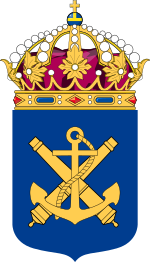Swedish Navy
|
Swedish Navy |
|
|---|---|
| Lineup | June 7, 1522 |
| Country |
|
| Armed forces | Swedish Armed Forces |
| Type | Armed forces |
| Strength | 7,100 (2008) |
| Main naval base | Karlskrona |
| commander | |
| Marine inspectors | Rear Admiral Ewa Skoog Haslum |
| insignia | |
| Navy coat of arms |

|
| The Swedish war flag |

|
The Swedish Navy ( Swedish Marines ) is the maritime arm of the Swedish Armed Forces . It consists of surface and underwater units - the fleet ( Flottan ) - as well as marine infantry units, the so-called Amphibious Corps ( Amfibiekåren ).
history
On June 7, 1522 just a year after the fall of Sweden from the Kalmar Union , the Regent and later King bought Gustav I. A number of ships of the Hanseatic city of Lübeck . This was the hour of birth of the Swedish Navy. The Wasa was a ship of the Swedish Navy in the 17th century, which was then known as the Royal Swedish Navy ( Kungliga flottan ).
The Amphibious Corps dates back to January 1, 1902, when a separate " Coastal Artillery " ( Kustartilleriet was set up) and navies from then on as the name of the entire branch of service functioned. In the last decade of the 20th century, the coastal fortifications were abandoned and the troops were transformed into regular marine infantry, which has been known as the Amphibious Corps since 2000 .
During a tense phase of the Cold War , the Swedish Navy was confronted several times with "phantom" or Soviet submarines that penetrated the archipelago in the early 1980s . On October 27, 1981, the Soviet U-137 whiskey class ran aground in a restricted area off Karlskrona, which caused an international scandal .
Sweden has been participating in UN missions with the Navy since 2006. The HMS Gävle was at the UNIFIL mission before Lebanon involved.
assignment
For many years the Swedish Navy had only one mission: to stop a major invasion across the Baltic Sea, preferably by causing large casualties, before the enemy reached the coast. With the collapse of the Soviet Union , this threat disappeared and the mission was partially redefined. The defensive character of the navy is still in the foreground today, but international operations within the framework of the EU membership of Sweden and the UN are conceivable.
The army and air force are strongly represented in UN missions. The navy did not have the necessary equipment because they had specialized too much in coastal defense. This changes with the introduction of the new Visby corvettes, which are approximately the size required for international missions.
organization
In the past, the navy was led by the naval commander ( Chefen för Marinen , CM ), who usually had the rank of vice admiral . This office was abolished, the leadership of the Navy restructured and renamed several times since 1995. The current commander of the naval forces ( Marinchef ) is Rear Admiral Ewa Skoog Haslum
The amphibious corps uses the same hierarchy as the army . The former commander in chief of the Swedish armed forces, Håkan Syrén , came from this branch of the navy.
Naval units
- 1st submarine flotilla ( 1st ubflj ), stationed in Karlskrona
- 3rd Navy Flotilla ( 3rd sjöstridsflj ), stationed in Karlskrona
- 4th Navy Flotilla ( 4th sjöstridsflj ), stationed in Berga / Muskö
Amphibious units
- Amphibious Regiment ( Amf 1 ) stationed in Berga
- Bevakningsbåtkompaniet (formerly Amf 4) in Gothenburg
bases
equipment
Unlike foreign naval forces, the Swedish navy was transformed into a pure coastal defense from 1958. It therefore has no large-scale units such as aircraft carriers , cruisers , nuclear submarines and destroyers . The largest combat ships today are corvettes . This limits the scope of the Navy. Smaller ships were considered more suitable for use on the coast, in the archipelago and in the Baltic Sea .
Most of the Swedish Navy's surface units are named after Swedish cities , while the submarines are named after Swedish provinces . The surface units are mostly small and rely on speed and flexibility. Examples of this are the corvettes of the Stockholm and Gothenburg classes . Currently, the Navy a new larger class into service: the stealth corvette of the Visby class . A new Gotland class of submarines , similar to the older Västergötland class , was recently commissioned. Its air-independent Stirling engine enables a previously unknown duration of underwater travel in conventional submarines.
The main transport vehicle of the Amphibious Corps is the Stridsbåt 90H , a small combat boat designed for 21 soldiers for rapid transports and landings in the archipelago. The corps is equipped with larger transport boats, but depends on the naval forces for heavy transport and rear cover.
See also
Web links
Individual evidence
- ^ Holger Paletschek: Schweden (Sweden). (No longer available online.) GlobalDefence.net, October 22, 2008, archived from the original on August 5, 2012 ; Retrieved April 1, 2010 . Info: The archive link was inserted automatically and has not yet been checked. Please check the original and archive link according to the instructions and then remove this notice.



